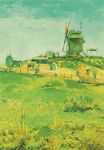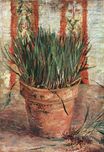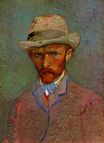Vincent van Gogh - Le Moulin de la Galette 1887
 |
 |
 |
 |
 |
 |
 |

Le Moulin de la Galette 1887
46x38cm oil/canvas
Pittsburgh, Carnegie Museum of Art
<< Previous G a l l e r y Next >>
From Carnegie Museum of Art, Pittsburgh:
In this small scene of Montmartre in Paris, the bright palette dominated by vibrant blues and greens may reflect Van Gogh’s exposure to contemporary trends toward bold color. He referenced Impressionist plein-air practice by including the small figure of a painter
with an easel near the fence at center left. The painting’s brightness stands in great contrast to the dark palette that dominated Van Gogh’s painting before his move to
Paris in 1886. The fresh palette echoes the delicate and feathery yet still visible and carefully controlled, brushstrokes with which the transparent-looking paint was
applied. Details such as blades of grass, small foliage, the rickety fence, buildings, and gardens at the top of the hill are rendered with fine, spidery lines. Toward
the bottom of the composition, blades of grass and yellow flowers are rendered in a notably larger scale, with thicker brushstrokes, to convey their proximity to the
viewer. The verticality of the composition enhances the slope of the hill, while the large windmill, the Moulin de Blute-Fin, draws the viewer’s eye to the
upper-center-right. A second, smaller windmill, the Moulin à Poivre, is seen to the left. In June 1886, Vincent and Theo moved to an apartment at 54, rue Lepic, which
overlooked the three windmills of Montmartre. The windmills were no longer functioning by then, and instead the area had been turned into a popular social hub, the
famed Moulin de La Galette. But Van Gogh focused on the topographical view of the structures and gardens, the color of the sky, and the nuances of the grassy hill
rather than the social bustle. Carnegie Museum of Art’s canvas is closely related to a painting titled The Moulin de Blute-Fin made in the summer of 1886 (Culture & Sport
Glasgow), although the brushwork in the Glasgow canvas is more pronounced. The carefully controlled brushwork and details seen in Carnegie Museum of Art’s painting have
led some scholars to speculate that it was finished in the studio.